Parker Vacumatic vs. Sheaffer Vacuum-Fil: Sheaffer Wins
by Jim Mamoulides, June 30, 2003, Updated August 11, 2023
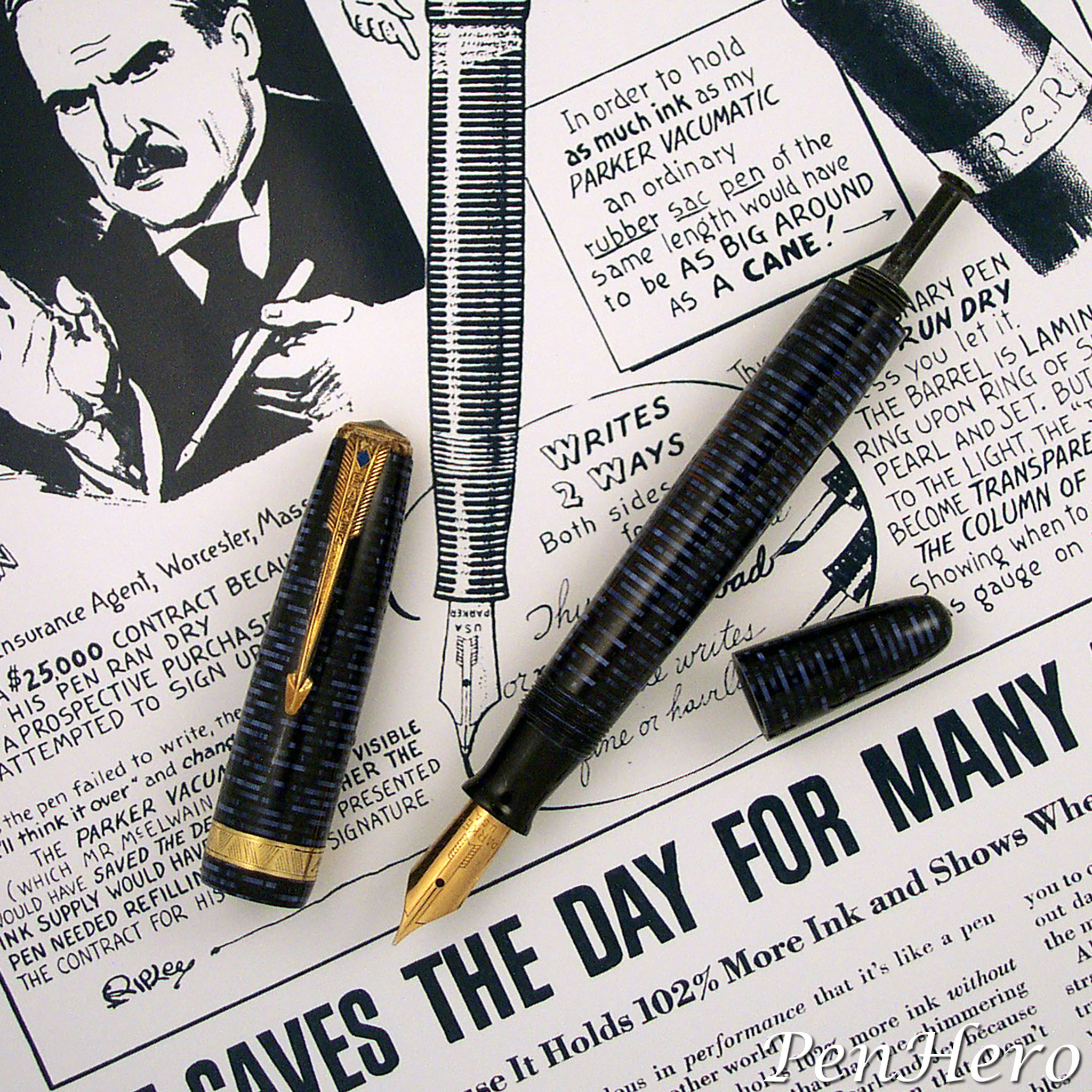 Parker Vacumatic fountain pen in Laminated Azure Blue Pearl 1945
Parker Vacumatic fountain pen in Laminated Azure Blue Pearl 1945
Clash Of The Titans
It's the mid 1930s and two of the giants of pendom have squared off, each with its own "sacless" pen, and each heralding it as a revolutionary development. Money was tight, the Depression was in full swing, and pen companies were looking for ways to sell more product and stay in business. Advertisements for both Parker and Sheaffer declared their new filling systems as a breakthrough. Quickly, as competition picked up, each began to take aim at their principal competitor, with more pointed, more direct “why our pen is better” advertisements and especially in dealer sales literature. There’s a fight night smack down looming on the horizon. Just wait till the Saturday night main event! In this article we’ll explore a lengthy set of sales claims Sheaffer made in “Fountain Pen Selling Facts: Helpful Information For Retail Salespeople,” probably released in 1934 when Sheaffer started selling Vacuum-Fil pens under the Sheaffer brand.
Parker got the early start with the Vacuum Filler, actually the second name used for their new diaphragm filling “sacless” pen which would eventually be called the Vacumatic. According to Parker Vacumatic by Geoffrey Parker, David Shepherd, and Dan Zazove, the pen was originally to be the Golden Arrow, and the Golden Arrow trademark was already owned by the Eagle Pencil Company and Eagle made a Golden Arrow pen in the England. I did a trademark search and Eagle had no such trademark registered in the United States. “Golden Arrow” was registered as a trademark on February 19, 1929 by Cluett Peabody & Company, the makers of Arrow brand shirts. It’s not clear if this had anything to do with Parker’s decision to change the name of the pen, but with no clarity on registration of the trademark, Parker decided to go with the name Vacuum Filler. As if to put this to bed, Parker did register Golden Arrow as a trademark in 1956. Dealers began to get the new $7.50 pen in November, 1932. The earliest advertisement I could find was a dealer ad in the November 20, 1932 Los Angeles Times. Parker began its national advertising later, with the earliest Saturday Evening Post ad in the March 18, 1933 issue.
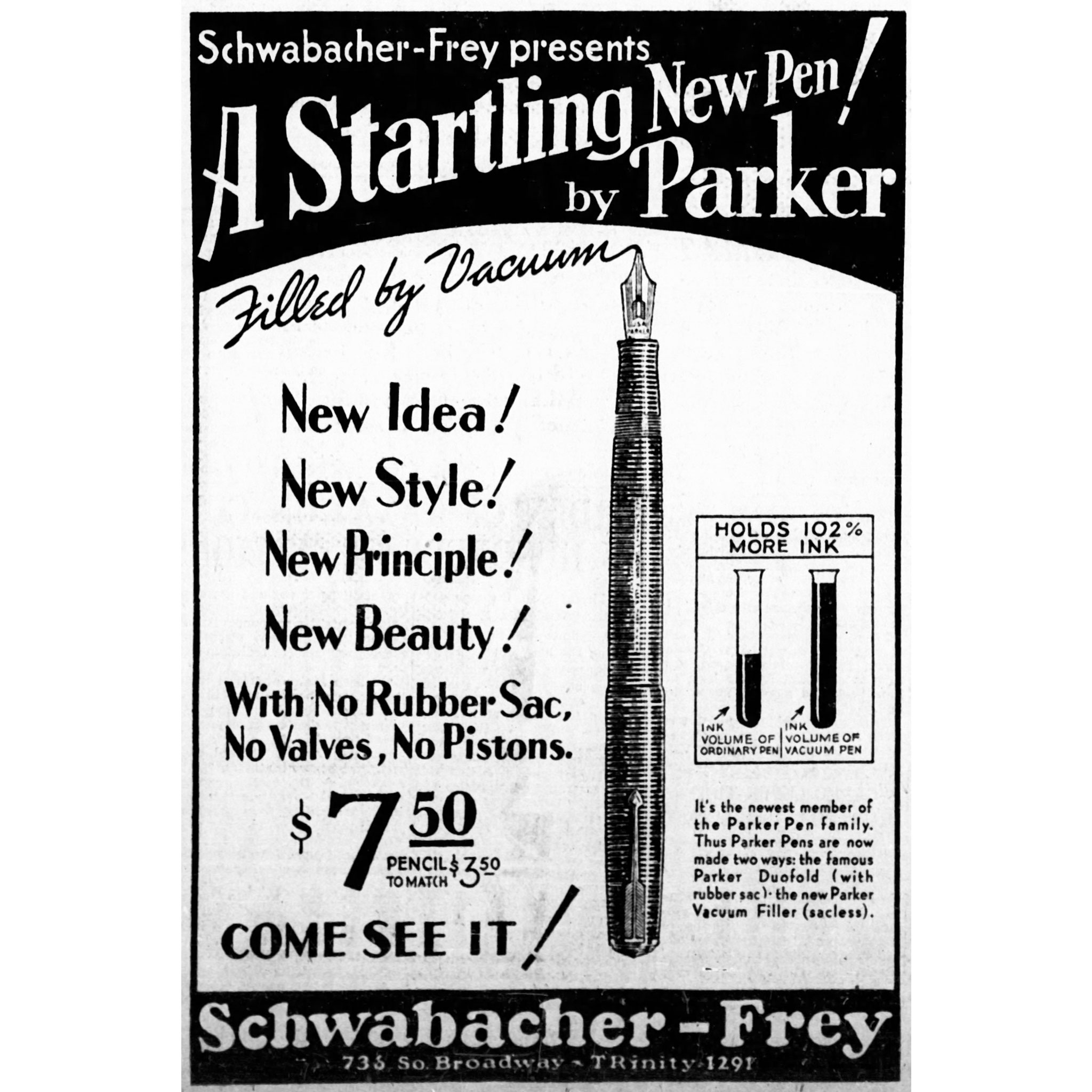 Advertisement, The Los Angeles Times, November 20, 1932
Advertisement, The Los Angeles Times, November 20, 1932
These early Parker advertisements proclaimed the new pen as “revolutionary,” “sacless,” “vacuum filled,” and with an "ever visible ink supply" holding "102% more ink without increasing the size." One of Parker's more memorable advertisements was a "Ripley's Believe It Or Not!" themed cartoon in the April 14, 1934 Saturday Evening Post showing and claiming, "14 parts that Parker eliminates by this revolutionary pen due to a basically new invention – the Vacumatic filler." Parker also showed the Vacumatic with a nib that "writes 2 ways", with the normal side writing fine, medium or broad, and the reverse side writing fine or hairline, having iridium tipping on both sides.
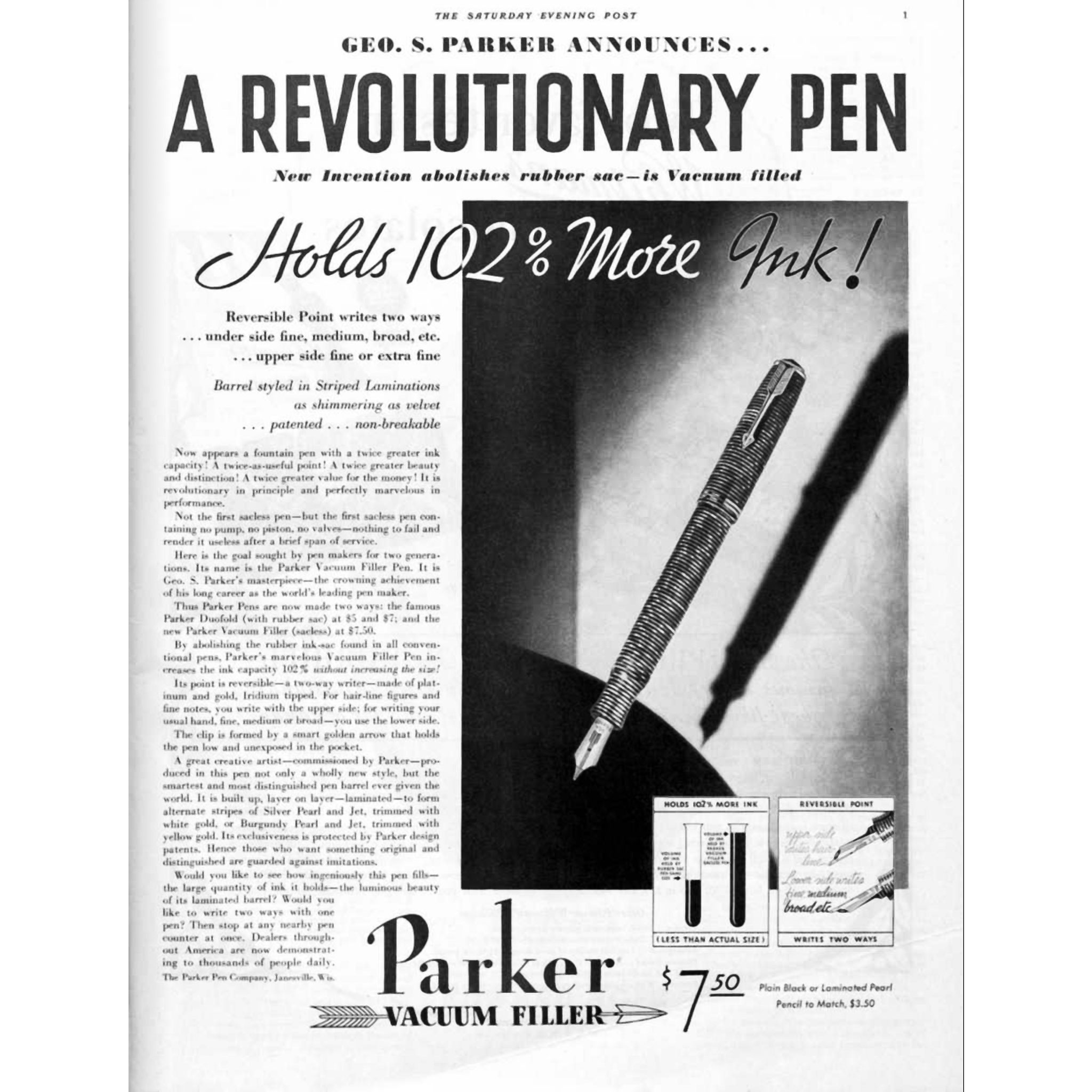 Advertisement, Saturday Evening Post, March 18, 1933
Advertisement, Saturday Evening Post, March 18, 1933
According to Parker Vacumatic by Geoffrey Parker, David Shepherd, and Dan Zazove, the patent used for the Vacumatic, number 1,904,358, filed in 1928 by Arthur O. Dahlberg of Lake Worth, Florida, was originally offered to Sheaffer, but the company declined. The patent was awarded on April 18, 1933. Dahlberg was awarded nine patents for Parker from 1921 to 1947 and not one for Sheaffer.
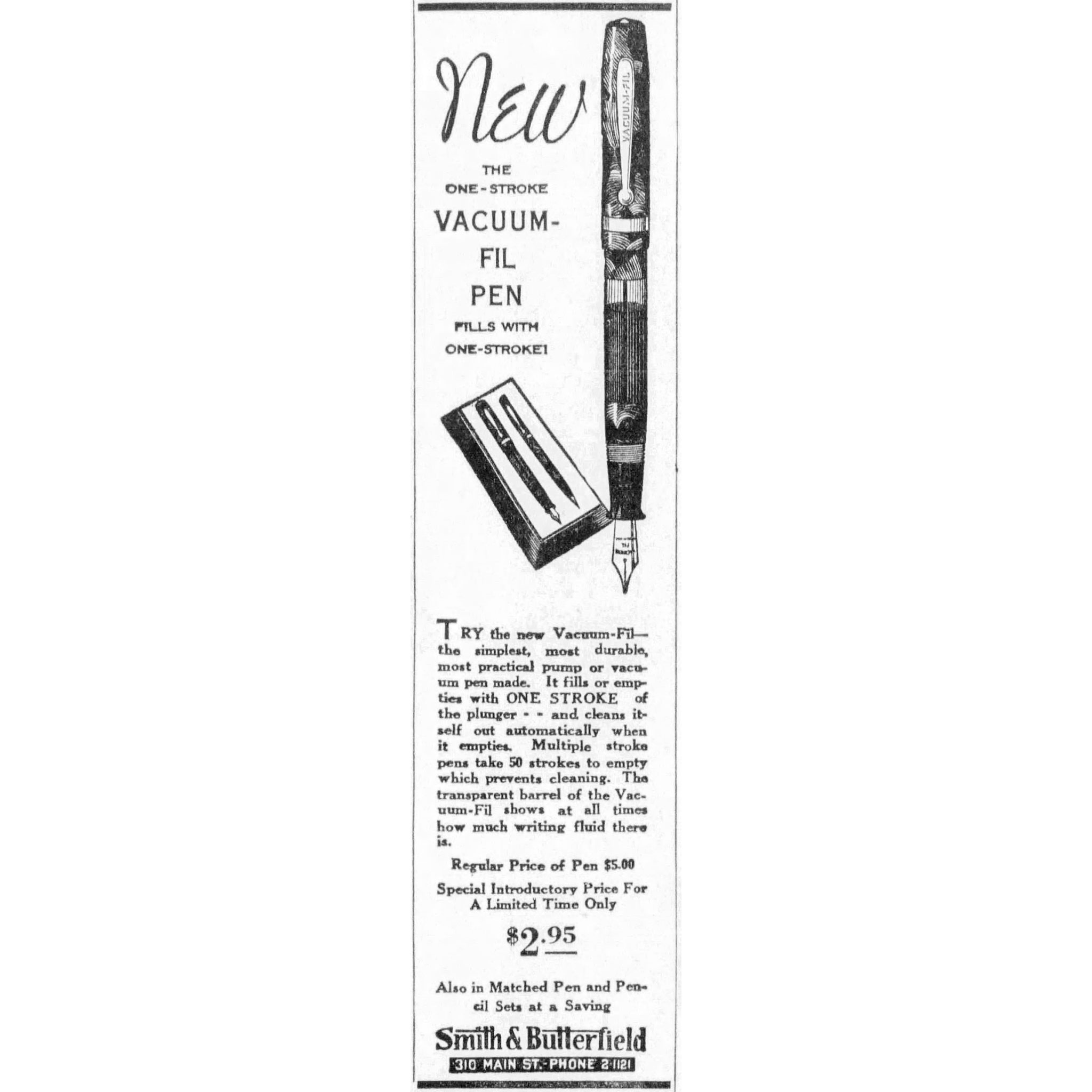 Advertisement, Delaware News Journal, December 5, 1933
Advertisement, Delaware News Journal, December 5, 1933
Sheaffer was late to the game by a year before offering its own vacuum type of pen. The company was also cautious, introducing the new Vacuum-Fil pen as a sub-brand without the Sheaffer name on it, renaming its Universal Pen Company subsidiary to Vacuum-Fil Pen Company, recorded in the Wilmington, Delaware News Journal on December 5, 1933. The earliest dealer ad I could find for the new Vacuum-Fil pen was January 31, 1934 in The Daily Times. The earliest company ad I could find was in the April 28, 1934 Saturday Evening Post. The Vacuum-Fil pen was aggressively priced at $2.95 with a gold nib, obviously intended to undercut the $7.50 price of the new Parker pen. Who made the new brand was no secret. In spite of Sheaffer creating visual distance from the Vacuum-Fil brand, dealers called the pen Sheaffer Vacuum-Fil pens in their ads and Sheaffer made clear to readers that the pens were made in Fort Madison, Iowa. The new pen must have been a success because by August, 1934, Vacuum-Fil Sheaffer Balance pens were being advertised.
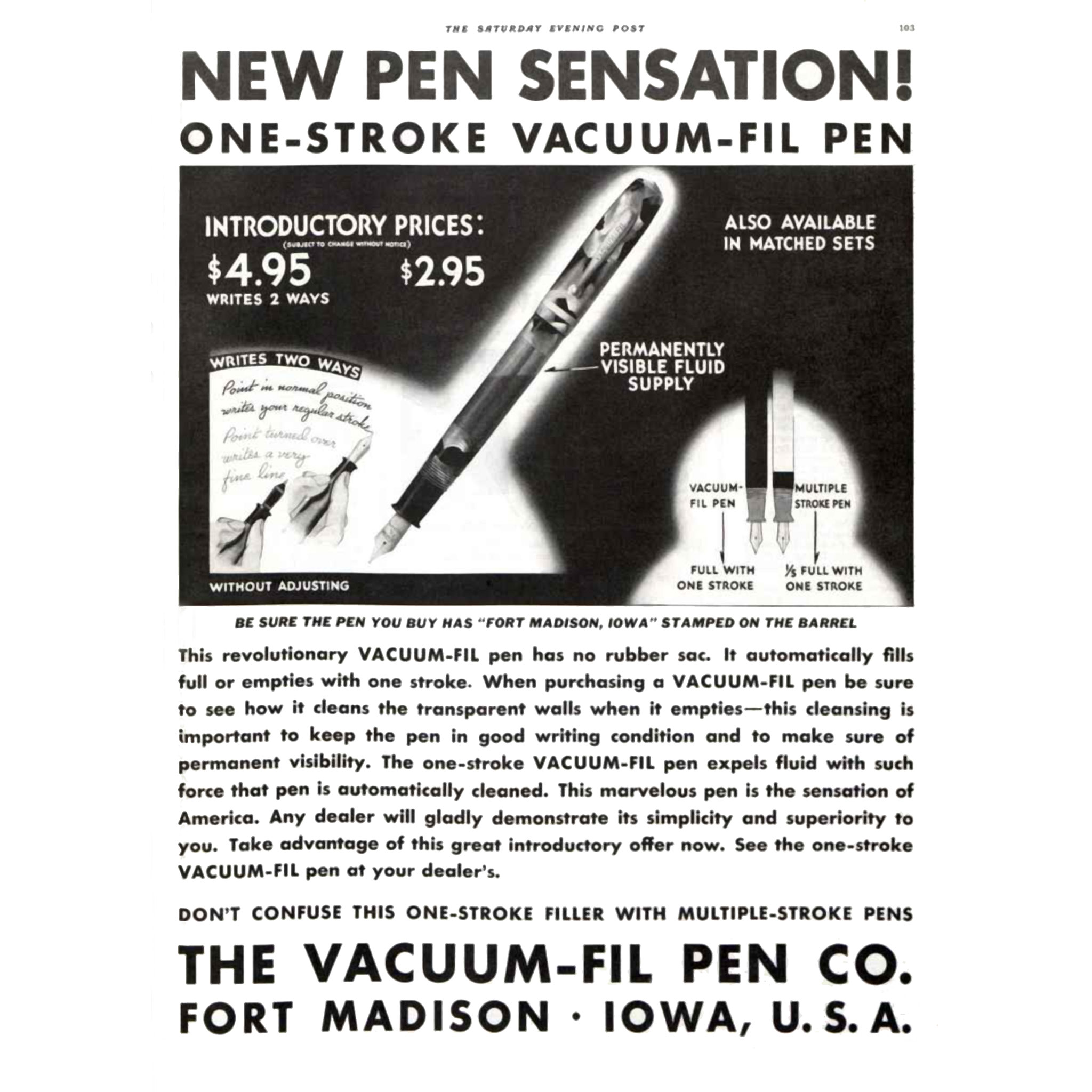 Advertisement, Saturday Evening Post, April 28, 1934
Advertisement, Saturday Evening Post, April 28, 1934
With Sheaffer offering many of the same features and advantages using a very different filling system, Parker began to take direct shots. "Don't confuse this sacless marvel with ordinary ink sac pens, or with so-called vacuum fillers having squirt-gun piston pumps and valves" is the first sentence in an October 27, 1934 Saturday Evening Post Parker Vacumatic ad. Parker took the technological superiority approach, stating a University of Wisconsin scientist invented the Vacumatic and that all other pens are essentially "old-fashioned."
Just The Facts, Ma'am
Of course, Sheaffer could not leave this unchallenged, releasing "Fountain Pen Selling Facts" as a guidebook for retail salespeople at Sheaffer dealers. This twelve-page booklet was specifically written to demonstrate, feature-by-feature, the superiority of the Vacuum-Fil pen over the Vacumatic, as well as reinforce the value of the Sheaffer lever-filler, Sheaffer’s Feathertouch nib, and Skrip ink. Throughout the booklet the message is "know your merchandise," recommend the item that gives "the best service," and "win satisfied customers."
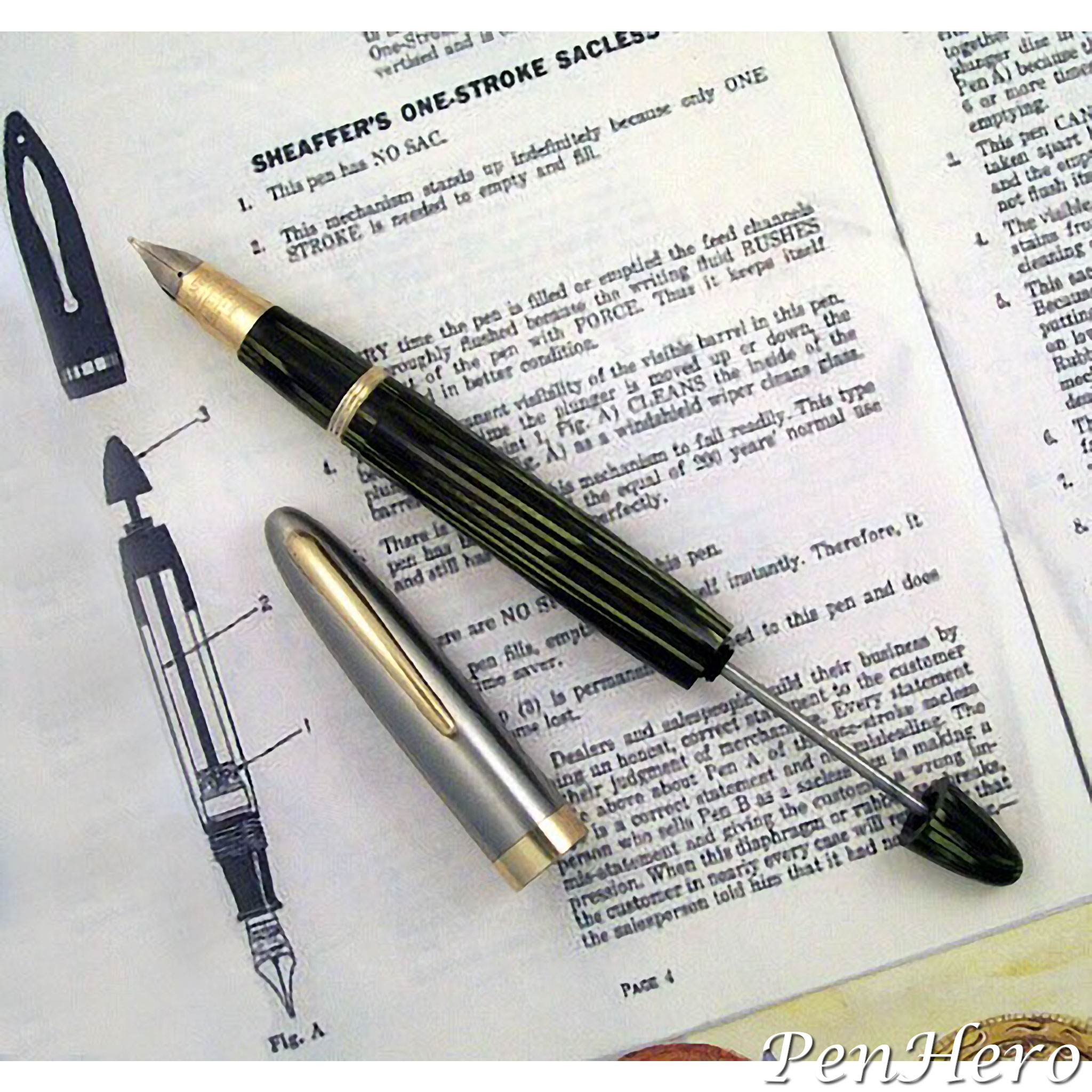 Sheaffer Triumph Sentinel Deluxe Vacuum-Fil fountain pen in green striped celluloid c. 1945-1947
Sheaffer Triumph Sentinel Deluxe Vacuum-Fil fountain pen in green striped celluloid c. 1945-1947
The booklet is a textbook on classic feature-by-feature comparison and contrast marketing. A retail salesperson who studied it would know all of Sheaffer’s product differentiation points and be able to answer any questions or challenges comparing the two lines.
It begins with a page that points out the benefits of knowing the product and selling the best value, which Sheaffer says will lead to more volume, more profits, better wages, and happier customers. These are statements that could be torn from any current marketing text but they set the tone for the rest of the booklet. Sheaffer will be making the case that it makes not only superior products, but only engages in above board market tactics, as opposed to "Brand X". This page also reminds the retailer that while competitors have offered a variety of guarantees on their pens, only Sheaffer has consistently offered a lifetime guarantee on its Lifetime White Dot pens that includes "accidental damage, as well as failure of performance from any other cause except willful abuse or loss."
Sacless vs. Diaphragm
The case is made on pages four and five: "Sheaffer's One-Stroke Sacless Pen Compared With Multiple Stroke Diaphragm Pen." On these pages, Sheaffer lays out eight positive features of the Vacuum-Fil pen on the left page and Sheaffer's view of the deficiencies of the Parker Vacumatic on the right hand page, including detailed and numbered technical diagrams of the Vacuum-Fil and Vacumatic pens.
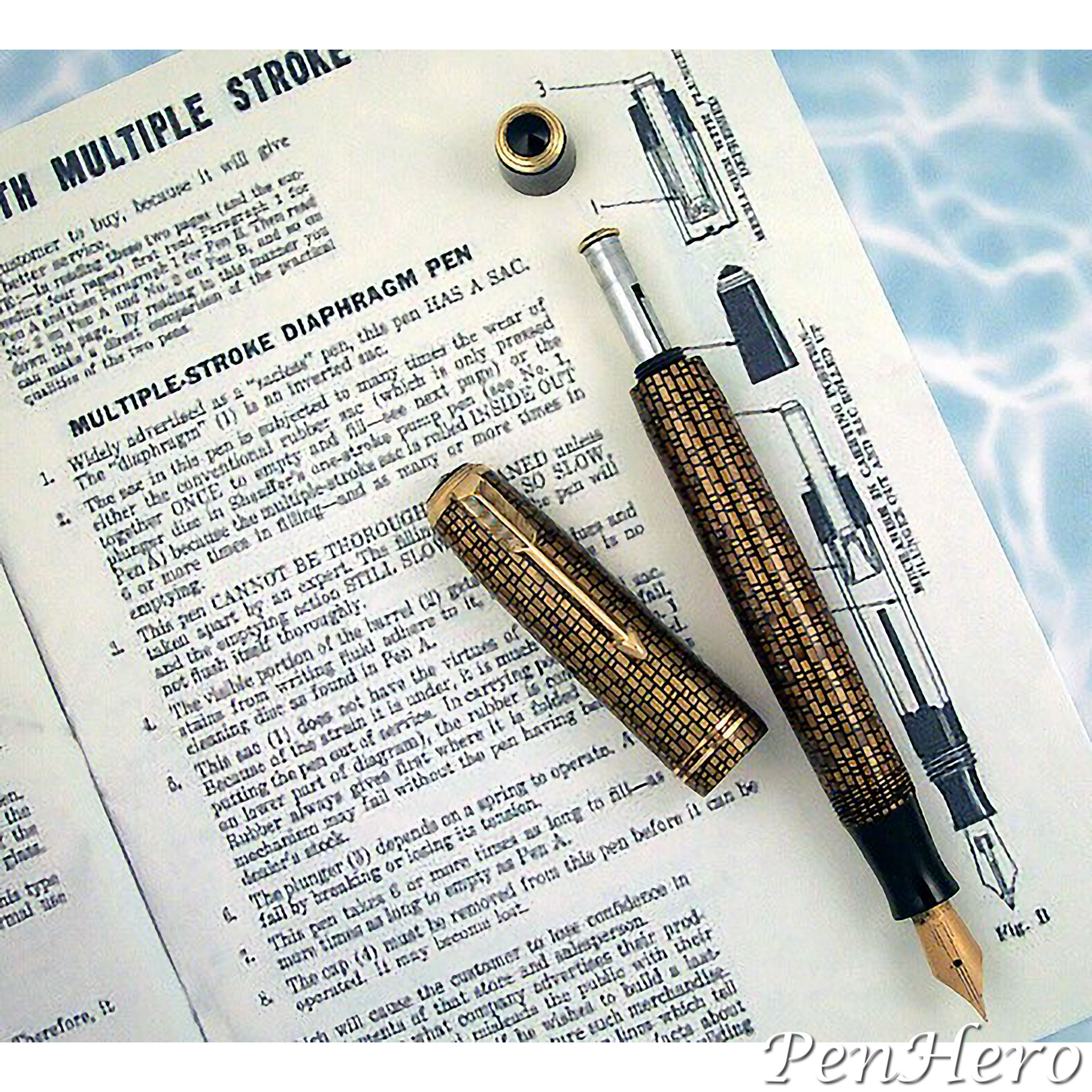 Parker Vacumatic Golden Web Juniorette fountain pen 1940
Parker Vacumatic Golden Web Juniorette fountain pen 1940
Sheaffer refers to the Vacuum-Fil pen as “Sheaffer’s One-Stroke Sacless Pen” and the Parker Vacumatic is not named but referred to as the “Multiple-Stroke Diaphragm Pen.” Below are the eight claims, along with Sheaffer's critique of the Vacumatic, grouped together, where each can be compared, with ellipses inserted to replace references to figures in the brochure:
1. Sacless or not
Sheaffer Vacuum-Fil: "This pen has NO SAC."
Parker Vacumatic: "Widely advertised as a 'sacless' pen, this pen HAS A SAC. The 'diaphragm' … is an inverted sac."
2. Durability of filling system
Sheaffer: “This mechanism stands up indefinitely because only ONE STROKE is needed to empty and fill."
Parker: “The sac in this pen is subjected to many times the wear of either the conventional rubber sac (which is only pressed together ONCE to empty and fill …) or the plunger disc in Sheaffer’s one-stroke pump pen … because the multiple stroke sac is rolled INSIDE OUT 6 or more times in filling – and as many or more times in emptying.”
3. Ease of cleaning
Sheaffer: "EVERY time the pen is filled or emptied the feed channels are thoroughly flushed because the writing fluid RUSHES in or out of the pen with FORCE. Thus, it keeps itself cleaner and in better condition.”
Parker: "This pen CANNOT BE THOROUGHLY CLEANED unless taken apart by an expert. The filling action is SO SLOW, and the emptying action STILL SLOWER, that the pen will not flush itself thoroughly."
4. Maintaining barrel clarity over time
Sheaffer: “There is permanent visibility of the visible barrel in this pen because each time the plunger is moved up or down, the plunger disc … CLEANS the inside of the barrel … as a windshield wiper cleans glass.”
Parker: “The visible portion of the barrel … gets dim as residues and stains from writing fluid adhere to it, because there is no cleaning disc … “
5. Weakness of rubber diaphragm design
Sheaffer: “There is nothing in this mechanism to fail readily. This type pen has been operated the equal of 200 years normal use and still has functioned perfectly.”
Parker: “This sac … does not have the virtues of the standard sac. Because of the strain it is under, it is much more apt to fail, putting the pen out of service. In carrying position … , the rubber is completely folded. Rubber always gives first where it is folded and thus this mechanism may fail without the pen having been out of the dealer’s stock.”
6. Weakness of using springs
Sheaffer: "There are NO SPRINGS in this pen."
Parker: "The plunger depends on a spring to operate. A spring can fail by breaking or losing its tension."
7. Ease of filling and cleaning
Sheaffer: “This pen fills, empties, cleans itself instantly. Therefore it is a time saver.”
Parker: “This pen takes 6 or more times as long to fill – as many or more times as long to empty … .”
8. Security of blind cap
Sheaffer: “The (blind) cap is permanently attached to the pen and does not become lost.”
Parker: “The (blind) … cap must be removed from this pen before it can be operated. It may become lost."
The language on these pages is quite strong, accusing Parker, without using their name, of making "so many misleading statements … that we have taken both types apart to show you what goes on inside them.” Further, the brochure makes the accusation that Parker was “advertising their products incorrectly and mislead(ing) the public with their statements.” In contrast, Sheaffer repeatedly emphasizes that its advertising has been honest, correct, and not misleading.
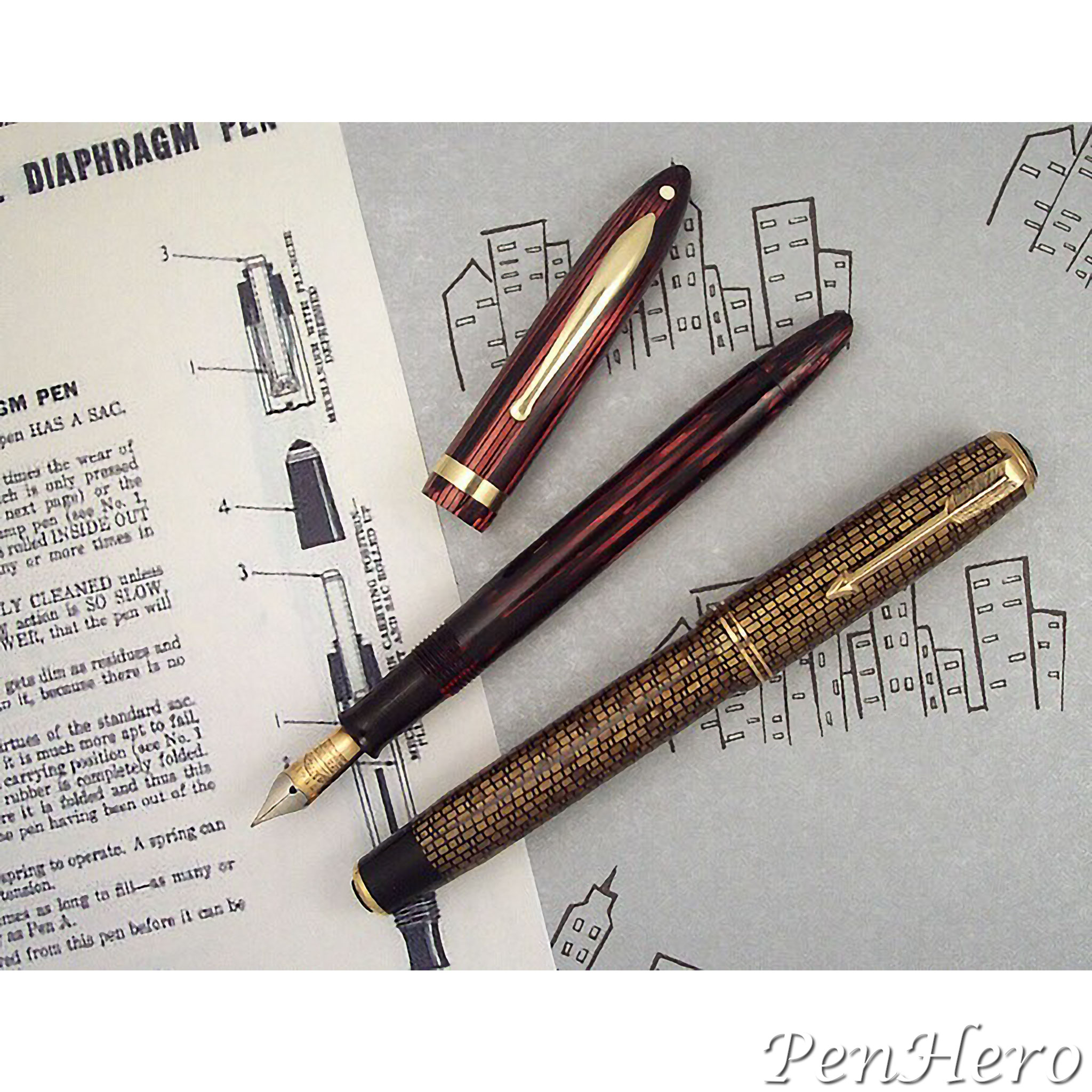 Sheaffer Balance Sovereign Carmine Vacuum-Fil and Parker Vacumatic Golden Web fountain pens
Sheaffer Balance Sovereign Carmine Vacuum-Fil and Parker Vacumatic Golden Web fountain pens
Tales of Gold and Platinum
If the filling system argument wasn't enough, Sheaffer then argues the merits of the Feathertouch nib, as compared to the "other type of gold and platinum point" on pages eight and nine. The fundamental argument is that Sheaffer’s platinum plating goes into the slit of the nib and the claim is made that this performs as a "lubricant" that improves the ink flow and "greases" the "ridges" caused from cutting the slit by "smoothing" the path for the ink and that platinum is superior to gold for this purpose. Sheaffer claimed that this platinum plating actually "speeds the flow of writing fluid" down the slit to the tip of the nib. The claim is also made that this platinum coating also makes two-way writing more effective by providing the same lubricating properties when the nib is inverted. Sheaffer claims that Parker's platinum masking is only on the face of the nib, not in the slit, making it mere decoration. It's a reverse pattern, with the masking literally outlining the slit.
In addition, Sheaffer spent additional time on its patented "Safety" feed. Sheaffer claims that their design regulates ink flow "controlled to the heart pierce so that it does not flow too freely." At the slit, the platinum plating takes over and "speeds the flow to the writing point." Sheaffer claimed that Parker's feed design has a channel running the length of the nib, "in contact with the point to the full distance," effectively negating any benefit plating the slit would achieve.
Let’s call this claim number nine.
How To Assess These Nine Claims?
With all that's at stake, let’s put these claims to a side-by-side test.
I’m going to group the nine total claims above into the following categories: design, longevity, and user experience. Let’s start with design, which covers claims 1, 5, 6 and 9. For claim 1, The Vacuum-Fil pen definitely has no sac. Sheaffer makes the claim that the Vacumatic rubber diaphragm is an inverted sac, which it is, though its purpose is not to hold ink. Technically, this is a point for Sheaffer. As to claim 5, weakness of using a rubber diaphragm and claim 6, weakness of using a spring in the filling system, it’s true both will get many more cycles than a single stroke filler over the same period. I can’t speak to durability without actual repair data, but Sheaffer’s system is simpler. I’ll give 2 points to Sheaffer here for simplicity. Lastly, arguing in claim 9 that platinum plating the nib slit significantly improves ink flow seems like magical thinking to me. If it was that important it would be adopted by every pen manufacturer and would have continued on for decades. A point to Parker here.
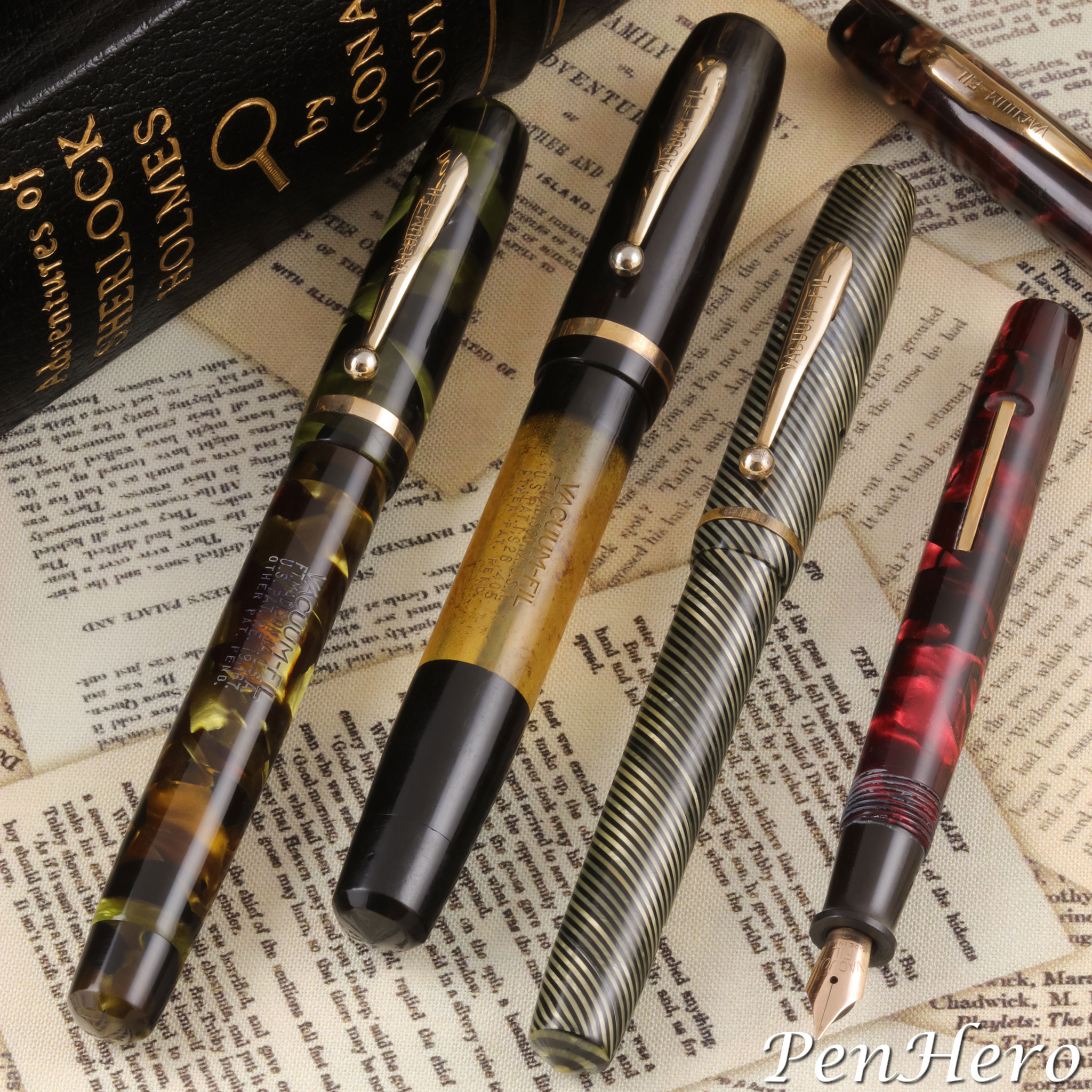 A Set of Sheaffer Vacuum-Fil brand fountain pens
A Set of Sheaffer Vacuum-Fil brand fountain pens
Let’s look next at longevity, claim 2 above. I don't have a time machine or repair history documents from fifty plus years ago, so I’ll look more to what a person will experience today. Both of these pens are advanced level repairs. Properly serviced, Vacuum-Fil and Vacumatic pens can work and write very nicely. In my experience, Vacuum-Fil pens cost more to service and fewer people do the work. I've also experienced several badly done Vacuum-Fil repairs that did not last. Based on that, I’ll give this point to Parker.
Finally, let’s look at the user experience, claims 3, 4, 7, and 8 above. The Vacuum-Fil is a one stroke pen, which is the key to claims 3 and 7, ease of cleaning and ease of filling. Filling is instantaneous and, with a well serviced pen, fills nearly completely full after one stroke. For the same reason, flushing the pen to empty it or change ink is just as simple and fast. Vacumatics take many strokes to fill and many more to empty and flush, very much as Sheaffer points out. These two points go to Sheaffer. The security of the blind cap, claim 8, goes to Sheaffer as there is nothing to lose. As to claim 4, maintaining barrel clarity during use, David Nishimura points out that “plunger-fillers retain barrel clarity far better than Vacumatics. The wiping action of the plunger does prevent buildup of ink residue inside the barrel. Plunger-fillers seldom require anything more than cleaning of the barrel to reveal what transparency remains. (Vacumatics) almost always require aggressive scrubbing or more.” It will definitely take longer to fully flush out a Vacumatic and it will not flush as clear. Point to Sheaffer on this one.
Let’s add it up: 7 points to Sheaffer, 2 to Parker, by my reckoning. Is it fair? I think most of Sheaffer’s claims are reasonable, even though they are cherry picked in Sheaffer's favor. In my experience, Vacuum-Fil pens fill instantly and write nicely. Vacumatics also write well but take annoyingly long to fill and flush. Both are advanced repairs, but Vacuum-Fil pens cost more to service and there are fewer people who work on them. Both offer lots of good choices of models over the nearly twenty years each were made. Do you like your stripes vertical or horizontal? Neither type is a bad choice.
Vive la difference!
Acknowledgements
Thanks to David Nishimura and Daniel Kirchheimer for fact checking on the Golden Arrow trademark and claim 4, maintaining barrel clarity parts of the article. These have been updated.
References
Advertisement, Saturday Evening Post, March 18 1933, page 1
Advertisement, Saturday Evening Post, April 15, 1933, page 1
Advertisement, Saturday Evening Post, May 13, 1933, page 1
Advertisement, Saturday Evening Post, June 10, 1933, page 1
Advertisement, Saturday Evening Post, July 8, 1933, page 1
Advertisement, Saturday Evening Post, September 2, 1933, page 1
Advertisement, Saturday Evening Post, September 30, 1933, page 1
Advertisement, Saturday Evening Post, April 14, 1934, page 1
Advertisement, Saturday Evening Post, April 28, 1934, page 103
Advertisement, Saturday Evening Post, August 11, 1934, inside front cover
Advertisement, Saturday Evening Post, September 8, 1934, inside front cover
Advertisement, Saturday Evening Post, October 6, 1934, inside front cover
Advertisement, Saturday Evening Post, October 27, 1934, page 1
Advertisement, The Daily Times, January 31, 1934, page 8
Advertisement, The Evansville Courier, February 18, 1934, page 8
Advertisement, The Los Angeles Times, November 20, 1932, page 2
“Fountain Pen Selling Facts: Helpful Information For Retail Salespeople” W. A. Sheaffer Pen Co., Fort Madison, Iowa, undated, probably as early as 1934
Fountain Pens: The Complete Guide to Repair & Restoration Revised Edition, Frank Dubiel, 2002
“New Corporations” The News Journal, December 5, 1933, page 31
“New Profitable Items for 1934” W. A. Sheaffer Pen Co., Fort Madison, Iowa, undated, 1934
Parker Vacumatic, Geoffrey Parker, David Shepherd, Dan Zazove, Surrenden Pens Limited, Brighton, UK, 2008, pages 48-81, 130-131
United States Patent number 1,904,358, awarded April 18, 1933, filed September 14, 1928 by Arthur O. Dahlberg of Lake Worth, Florida and assigned to the Parker Pen Company
United States Trademark number 252,908 registered February 19, 1929 by Cluett Peabody & Company, the makers of Arrow brand shirts
United States Trademark number 628,281 registered June 5, 1956 by the Parker Pen Company
Interact
Comments on this article may be sent to the author, Jim Mamoulides


